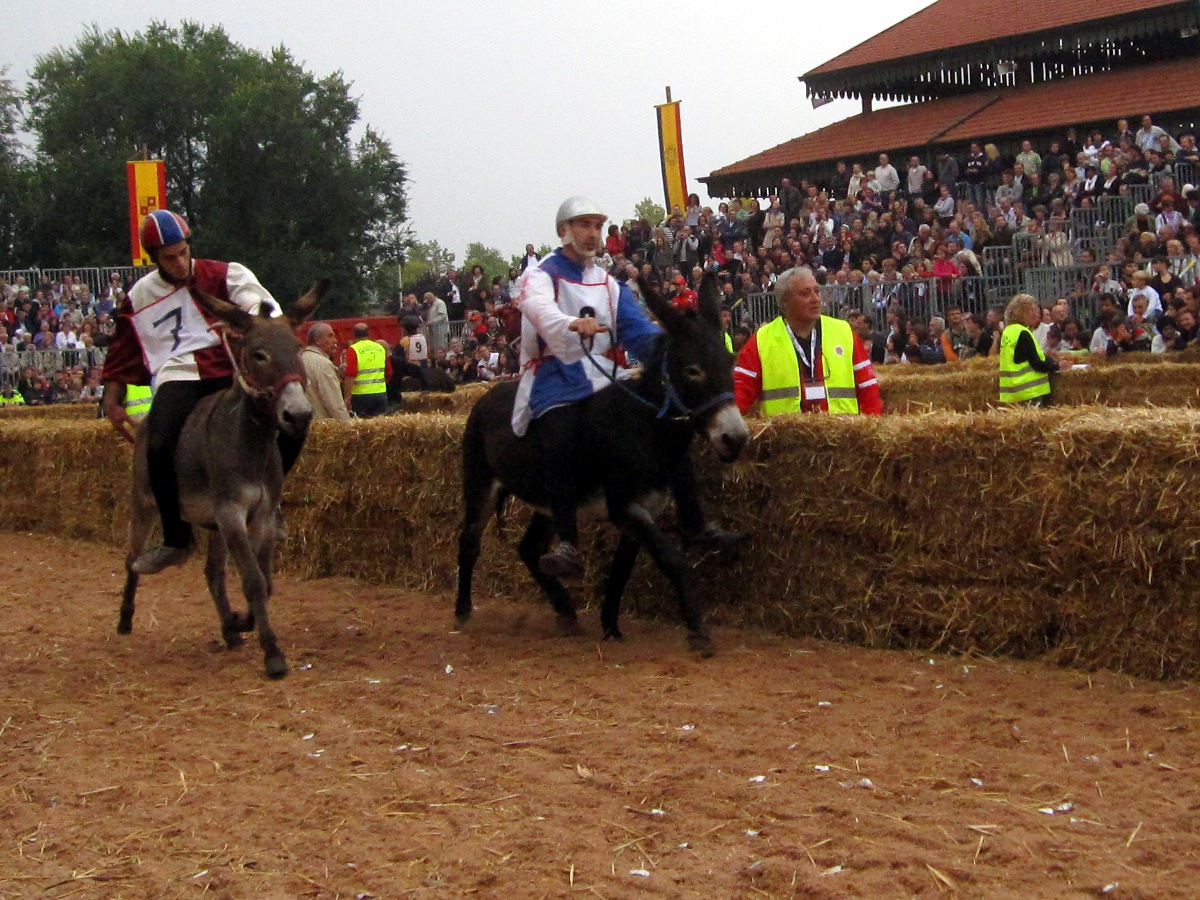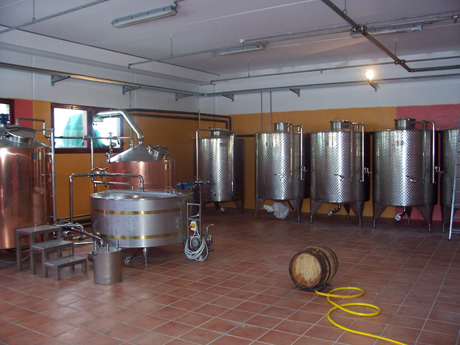SwissMiss pointed me to this gorgeous poster from the Mutato-Archive, a collection of misshapen and irregular fruits, vegetables and roots. With an eye for color and careful selection, Uli Westphal took dozens of photos of gnarly tubers, trident-shaped carrots and Siamese mushrooms. In other words, the set is a stunning display of natural diversity.

Too often, produce is bred to be perfectly uniform, symmetric and well, monotonous. Anything that shows a little too much character is often thrown out at the supermarket. What a shame! At least the EU has finally abandoned a law that bans the sale of irregularly-shaped but still nutritious produce. Maybe it’s not always about looks after all.
Continue reading Mutato-Archive: Celebrating the Beauty of Heterogeneous Fruit
Tag Archives: piedmont
Winter in Italy
Today I woke to find that everything was covered in a pristine blanket of fluffy, white snow. It was the first snowfall of the season in Bra.
Townspeople gather to read town notices on the bulletin board outside the church.
In Italy, umbrellas are commonly used by pedestrians to shield themselves from falling snow.
Continue reading Winter in Italy
Bad Ass Racing: Alba’s Palio degli Asini
What’s furry, recalcitrant, and represents a medieval middle-finger? The Alba Palio degli Asini donkey race, of course!
You see, in 1275, the Piedmont towns of Asti and Alba were at war. On August 10, the feast day for Alba’s patron saint San Lorenzo, Asti attacked Alba and laid waste to the fields outside the city walls. To further cement their victory and humiliate the people of Alba, Asti’s army held a horse race around the Alba city walls. According to legend, the residents of Alba simultaneously held a donkey race inside the city walls, as a thumb to the noses of their aggressors.
Fast forward a few centuries, and Asti began regularly running its famed palio horse race in 1929 after a few decades of hiatus. However, jockeys from Alba kept winning and tempers flared, so in 1932, Asti decided to withdraw their invitation to Alba. In response to the snub, Alba launched its own palio, only staged with donkeys. The cheeky competition parodies the prestigious Palio di Asti, and also marks the launch of the annual Alba truffle fair.
Continue reading Bad Ass Racing: Alba’s Palio degli Asini
Hiking and Ruminating the Italian Alps
Clockwise: Mural of a mountain goat and cow outside Fratelli Lussiana creamery, fresh wheels of cevrin in warm room, foothills of Piedmont, aging wheels of cevrin in cold room
A couple weeks ago while on the Piedmont stage, our class visited Fratelli Lussiana creamery, a cheese producer in Giaveno, about 35 km west of Turin. The primary cheese they produce is cevrin di Coazze, made with half goat and half cow’s milk and aged for 3 months. At the time, I was tired, hot and not in the mood to see yet another farm, but we all fell headlong in love with this cheese producer. After showing us an overview of the cheesemaking process and aging rooms, the lovely Lussiana siblings piled us into a hay-filled tractor and trundled us up a narrow, rocky mountain path, while we tried to keep our balance, yodeled and ducked under overhanging tree branches. Once we reached the mountaintop farm, we were greeted by a herd of seriously dexterous goats, placidly ruminating cows, and the friendliest donkey in the world (who kept sneaking into photos and nuzzling for attention). The farm caretakers welcomed us with fresh wheels of cevrin, salame, bread and red wine, and we ate cheese next to the animals who produced the milk for it, as the sun went down over the Italian Alps. It was one of the best days of my life.
Determined to recapture some of that high, some of my classmates decided to contact Fratelli Lussiana and ask if they would allow us to return for a second visit. Only, this time we wanted to see the cevrin making process, which happens every morning at 6 am. With the 90 minute drive from Bra, this meant that we would be setting out on a 4:30 am road trip. Totally worth it!
After duly waking up at a rather uncivilized hour, the first challenge was figuring out how to get back to the creamery. We were armed with an address of questionable accuracy (the GPS was telling us to go to a different town) and also a phone number. To complicate matters, no one present was terribly fluent in Italian. So, over the next hour, we called three times, and using an amalgamation of broken Italian and French, managed to get within a few streets of the creamery. As we drove through Giaveno, desperately looking for familiar landmarks, we spotted an elderly gentlemen walking briskly down the street. I rolled down a window and asked him for directions to Fratelli Lussiana, and he broke into a toothy grin and began to wave wildly. Seeing our blank reactions, the man said, “You know what, I’d better just point out the way myself, do you mind if I hop in the car?” And before I knew it, I was scooting to make room for a swarthy Italian man in the backseat. We explained that we were students at the University of Gastronomic Sciences, interested in cheesemaking, and he said “Ah yes, of course! Who do you know of the Lussiana brothers? Oh Luigi, yes I know Luigi!” Within a few minutes, he had steered us to the creamery. We thanked him for his help and asked if he needed a ride back. “No no, I walk a lot, 20 km a day! I’ll be just fine.” He stuck his head into the barn to say hello to Luigi, and sauntered off back into town.
Continue reading Hiking and Ruminating the Italian Alps
I Went To Jail For Beer
A cackling rooster call pierced the silence, followed by the sound of quiet laughter. We stood in a courtyard ringed by oppressively institutional gray buildings, and I swiveled my head nervously as a stiff breeze blew through Saluzzo. The giggly presence of two dozen young students had attracted some attention from the residents of this casa di reclusione. In less euphemistic, non-Italian terms, that would be a prison.
“Welcome to the Saluzzo prison,” said our guide, Andrea. “I apologize for the ID screening and metal detector. As you can see, it is very difficult to visit here, but visitors are very important because they provide a window to the outside world. In return, we will now drink.”
Moving along the sidewalk, we turned a corner and were confronted with the intense smell of warm bread. We had arrived here to see the Pausa Cafe brewery project, a non-profit cooperative that works with prisons in Torino and Saluzzo in beer brewing and coffee cafe programs. The mission is to help rehabilitate prisoners and give them productive skills that they can use once no longer behind bars. The cooperative began in 2004, and has successfully employed about 30 prisoners over the last few years. None have been reincarcerated once released from prison. Currently, the Saluzzo brewery employs 3 prisoners, along with 2 non-inmates, and inmate employees are paid 900 euros per month. The brewery produces around 50.000 liters of beer annually, which is sold in Coop grocery chains, gourmet groceries, CSAs, and exported to Norway and the US.
Continue reading I Went To Jail For Beer
Historical Wine Cellars in Piedmont

At the Wine Bank: a map of Italy’s most important varietals and their regions
The Piemonte region is an area in northwestern Italy, bordering France and Switzerland, with distinct seasons and mountainous terrain (literally: “foot of the mountain”). It is considered one of the greatest winemaking regions in Italy, renowned for its Barolo and Barbaresco red wines made from Nebbiolo grapes.
For the first day of the Piedmont stage, we stopped by the Banca del Vino (wine bank) housed inside the Agenzia di Pollenzo, which is also home to (you guessed it) the University of Gastronomic Sciences. Ah, familiar stomping grounds. Inspired by a vision from Carlo Petrini, the Banca del Vino is an effort to build a historical record of Italian wines, to select, stock and maintain the best of the Italian peninsula. Thus, the vault is part storage cellar, part museum, and holds a collection of wines from over 300 producers across Italy while providing tastings for visitors. They also offer themed workshops if you are interested in researching one region or varietal in particular. Outside of the vault, a large number of wines line the shelves and are available for sale. I was amused to see one labeled “Cornell,” although additional research suggests that the wine has nothing to do with my alma mater or Ezra Cornell’s descendants.
Continue reading Historical Wine Cellars in Piedmont










